A Sustainability Approach between the Water–Energy–Food Nexus and Clean Energy
Abstract
1. Introduction
2. Materials and Methods
3. Results
3.1. Analysis of Intellectual Structure
Bibliometric Networks
3.2. Systematic Review of WEF Nexus, Clean Energy, and Sustainability
4. Discussion
5. Conclusions
Supplementary Materials
Author Contributions
Funding
Data Availability Statement
Acknowledgments
Conflicts of Interest
References
- Liang, H.; Shi, C.; Abid, N.; Yu, Y. Are Digitalization and Human Development Discarding the Resource Curse in Emerging Economies? Resour. Policy 2023, 85, 103844. [Google Scholar] [CrossRef]
- Wang, T.; Li, M.; Rasheed, M.F. The Nexus between Resource Depletion, Price Fluctuations, and Sustainable Development in Expenditure on Resources. Resour. Policy 2024, 89, 104629. [Google Scholar] [CrossRef]
- Boţa-Avram, C.; Apostu, S.A.; Ivan, R.; Achim, M.V. Exploring the Impact of Macro-Determinant Factors on Energy Resource Depletion: Evidence from a Worldwide Cross-Country Panel Data Analysis. Energy Econ. 2024, 130, 107341. [Google Scholar] [CrossRef]
- The World Bank Energy. Available online: https://www.worldbank.org/en/topic/energy/overview#1 (accessed on 3 December 2023).
- Zillman, J.W. The IPCC Third Assessment Report on the Scientific Basis of Climate Change. Australas. J. Environ. Manag. 2001, 8, 169–185. [Google Scholar] [CrossRef]
- Berrezueta, E.; Kovacs, T.; Herrera-Franco, G.; Mora-Frank, C.; Caicedo-Potosí, J.; Carrion-Mero, P.; Carneiro, J. Laboratory Studies on CO2-Brine-Rock Interaction: An Analysis of Research Trends and Current Knowledge. Int. J. Greenh. Gas Control 2023, 123, 103842. [Google Scholar] [CrossRef]
- Johnsson, F.; Kjärstad, J.; Rootzén, J. The Threat to Climate Change Mitigation Posed by the Abundance of Fossil Fuels. Clim. Policy 2019, 19, 258–274. [Google Scholar] [CrossRef]
- Welsby, D.; Price, J.; Pye, S.; Ekins, P. Unextractable Fossil Fuels in a 1.5 °C World. Nature 2021, 597, 230–234. [Google Scholar] [CrossRef]
- Wood, N.; Roelich, K. Tensions, Capabilities, and Justice in Climate Change Mitigation of Fossil Fuels. Energy Res. Soc. Sci. 2019, 52, 114–122. [Google Scholar] [CrossRef]
- Ritchie, H.; Roser, M. CO2 Emissions. Available online: https://ourworldindata.org/co2-emissions (accessed on 9 February 2024).
- Energy Institute Statistical Review of World Energy (2023)—With Major Processing. Available online: https://ourworldindata.org/grapher/energy-consumption-by-source-and-country (accessed on 9 February 2024).
- Butlin, J. Our Common Future. By World Commission on Environment and Development. (London, Oxford University Press, 1987, Pp.383 £5.95.). J. Int. Dev. 1989, 1, 284–287. [Google Scholar] [CrossRef]
- World Commission on Environment and Development. Our Common Future; Oxford University Press: New York, NY, USA, 1987. [Google Scholar]
- Ruggerio, C.A. Sustainability and Sustainable Development: A Review of Principles and Definitions. Sci. Total Environ. 2021, 786, 147481. [Google Scholar] [CrossRef] [PubMed]
- United Nations The Paris Agreement. Available online: https://www.un.org/en/climatechange/paris-agreement (accessed on 9 February 2024).
- Adom, R.K.; Simatele, M.D.; Reid, M. Addressing the Challenges of Water-Energy-Food Nexus Programme in the Context of Sustainable Development and Climate Change in South Africa. J. Water Clim. Chang. 2022, 13, 2761–2779. [Google Scholar] [CrossRef]
- Simpson, G.B.; Jewitt, G.P.W. The Development of the Water-Energy-Food Nexus as a Framework for Achieving Resource Security: A Review. Front. Environ. Sci. 2019, 7, 9. [Google Scholar] [CrossRef]
- Terrapon-Pfaff, J.; Ortiz, W.; Dienst, C.; Gröne, M.-C. Energising the WEF Nexus to Enhance Sustainable Development at Local Level. J. Environ. Manag. 2018, 223, 409–416. [Google Scholar] [CrossRef] [PubMed]
- Hoolohan, C.; Larkin, A.; McLachlan, C.; Falconer, R.; Soutar, I.; Suckling, J.; Varga, L.; Haltas, I.; Druckman, A.; Lumbroso, D.; et al. Engaging Stakeholders in Research to Address Water–Energy–Food (WEF) Nexus Challenges. Sustain. Sci. 2018, 13, 1415–1426. [Google Scholar] [CrossRef] [PubMed]
- Albrecht, T.R.; Crootof, A.; Scott, C.A. The Water-Energy-Food Nexus: A Systematic Review of Methods for Nexus Assessment. Environ. Res. Lett. 2018, 13, 043002. [Google Scholar] [CrossRef]
- Herrera-Franco, G.; Bollmann, H.A.; Pasqual Lofhagen, J.C.; Bravo-Montero, L.; Carrión-Mero, P. Approach on Water-Energy-Food (WEF) Nexus and Climate Change: A Tool in Decision-Making Processes. Environ. Dev. 2023, 46, 100858. [Google Scholar] [CrossRef]
- Vakilifard, N.; Anda, M.; Bahri, P.A.; Ho, G. The Role of Water-Energy Nexus in Optimising Water Supply Systems—Review of Techniques and Approaches. Renew. Sustain. Energy Rev. 2018, 82, 1424–1432. [Google Scholar] [CrossRef]
- De Stercke, S.; Chaturvedi, V.; Buytaert, W.; Mijic, A. Water-Energy Nexus-Based Scenario Analysis for Sustainable Development of Mumbai. Environ. Model. Softw. 2020, 134, 104854. [Google Scholar] [CrossRef]
- Harwood, S.A. In Search of a (WEF) Nexus Approach. Environ. Sci. Policy 2018, 83, 79–85. [Google Scholar] [CrossRef]
- Huang, D.; Li, G.; Sun, C.; Liu, Q. Exploring Interactions in the Local Water-Energy-Food Nexus (WEF-Nexus) Using a Simultaneous Equations Model. Sci. Total Environ. 2020, 703, 135034. [Google Scholar] [CrossRef]
- Fernández-Ríos, A.; Laso, J.; Campos, C.; Ruiz-Salmón, I.; Hoehn, D.; Cristóbal, J.; Batlle-Bayer, L.; Bala, A.; Fullana-i-Palmer, P.; Puig, R.; et al. Towards a Water-Energy-Food (WEF) Nexus Index: A Review of Nutrient Profile Models as a Fundamental Pillar of Food and Nutrition Security. Sci. Total Environ. 2021, 789, 147936. [Google Scholar] [CrossRef]
- Leck, H.; Conway, D.; Bradshaw, M.; Rees, J. Tracing the Water–Energy–Food Nexus: Description, Theory and Practice. Geogr. Compass 2015, 9, 445–460. [Google Scholar] [CrossRef]
- Naidoo, D.; Nhamo, L.; Mpandeli, S.; Sobratee, N.; Senzanje, A.; Liphadzi, S.; Slotow, R.; Jacobson, M.; Modi, A.T.; Mabhaudhi, T. Operationalising the Water-Energy-Food Nexus through the Theory of Change. Renew. Sustain. Energy Rev. 2021, 149, 111416. [Google Scholar] [CrossRef]
- Pittock, J.; Hussey, K.; McGlennon, S. Australian Climate, Energy and Water Policies: Conflicts and Synergies. Aust. Geogr. 2013, 44, 3–22. [Google Scholar] [CrossRef]
- Pasqual, J.C.; Lardizabal, C.C.; Herrera, G.; Bollmann, H.A.; Nunes, E.O. Water-Energy-Food Nexus: Comparative Scenarios and Public Policy Perspectives from Some Latin American Countries Regarding Biogas from Agriculture and Livestock. J. Agric. Sci. Technol. A 2015, 5, 408–427. [Google Scholar] [CrossRef]
- Li, G.; Wu, Y.; Zhang, Y.; Zhi, R.; Wang, J.; Ma, C. Performance Study on a Single-Screw Expander for a Small-Scale Pressure Recovery System. Energies 2016, 10, 6. [Google Scholar] [CrossRef]
- Carrión-Mero, P.; Morante-Carballo, F.; Herrera-Franco, G.; Jaya-Montalvo, M.; Rodríguez, D.; Loor-Flores de Valgas, C.; Berrezueta, E. Community-University Partnership in Water Education and Linkage Process. Study Case: Manglaralto, Santa Elena, Ecuador. Water 2021, 13, 1998. [Google Scholar] [CrossRef]
- Sun, C.; Yan, X.; Zhao, L. Coupling Efficiency Measurement and Spatial Correlation Characteristic of Water–Energy–Food Nexus in China. Resour. Conserv. Recycl. 2021, 164, 105151. [Google Scholar] [CrossRef]
- Chamas, Z.; Abou Najm, M.; Al-Hindi, M.; Yassine, A.; Khattar, R. Sustainable Resource Optimization under Water-Energy-Food-Carbon Nexus. J. Clean. Prod. 2021, 278, 123894. [Google Scholar] [CrossRef]
- Zhang, Y.; Li, L.; Sadiq, M.; Chien, F. The Impact of Non-Renewable Energy Production and Energy Usage on Carbon Emissions: Evidence from China. Energy Environ. 2023, 0958305X2211504. [Google Scholar] [CrossRef]
- Chen, Y.; Shao, S.; Fan, M.; Tian, Z.; Yang, L. One Man’s Loss Is Another’s Gain: Does Clean Energy Development Reduce CO2 Emissions in China? Evidence Based on the Spatial Durbin Model. Energy Econ. 2022, 107, 105852. [Google Scholar] [CrossRef]
- Patil, P.B.; Sarkar, D.; Sarkar, A. Chapter 1—Clean Energy Production by Microorganisms: A Sustainable Approach. In Relationship between Microbes and the Environment for Sustainable Ecosystem Services; Samuel, J., Kumar, A., Singh, J., Eds.; Elsevier: Amsterdam, The Netherlands, 2023; pp. 1–14. ISBN 978-0-323-89936-9. [Google Scholar]
- Bielecki, A.; Ernst, S.; Skrodzka, W.; Wojnicki, I. The Externalities of Energy Production in the Context of Development of Clean Energy Generation. Environ. Sci. Pollut. Res. 2020, 27, 11506–11530. [Google Scholar] [CrossRef] [PubMed]
- Hosseini, S.E.; Wahid, M.A. Hydrogen from Solar Energy, a Clean Energy Carrier from a Sustainable Source of Energy. Int. J. Energy Res. 2020, 44, 4110–4131. [Google Scholar] [CrossRef]
- Karatayev, M.; Hall, S.; Kalyuzhnova, Y.; Clarke, M.L. Renewable Energy Technology Uptake in Kazakhstan: Policy Drivers and Barriers in a Transitional Economy. Renew. Sustain. Energy Rev. 2016, 66, 120–136. [Google Scholar] [CrossRef]
- Song, H.; Liu, Y.; Bian, H.; Shen, M.; Lin, X. Energy, Environment, and Economic Analyses on a Novel Hydrogen Production Method by Electrified Steam Methane Reforming with Renewable Energy Accommodation. Energy Convers. Manag. 2022, 258, 115513. [Google Scholar] [CrossRef]
- Zhai, X.; Cheng, Z.; Chang, S.; Ai, X.; Zhang, X. An Analysis on the Current Situation of Energy Development and Its Environmental Problems in Yulin City. Energy Rep. 2020, 6, 15–20. [Google Scholar] [CrossRef]
- Brodny, J.; Tutak, M.; Bindzár, P. Assessing the Level of Renewable Energy Development in the European Union Member States. A 10-Year Perspective. Energies 2021, 14, 3765. [Google Scholar] [CrossRef]
- Gunnarsdottir, I.; Davidsdottir, B.; Worrell, E.; Sigurgeirsdottir, S. Sustainable Energy Development: History of the Concept and Emerging Themes. Renew. Sustain. Energy Rev. 2021, 141, 110770. [Google Scholar] [CrossRef]
- Herrera-Franco, G.; Bollmann, H.A.; Pasqual Lofhagen, J.C.; Mora-Frank, C. Analysis of the Water–Energy–Food Nexus and Its Contribution to Energy Development. In Energy Production and Management in the 21st Century V; WIT Press: Southampton, UK, 2022; pp. 81–91. [Google Scholar]
- Scardigno, A. New Solutions to Reduce Water and Energy Consumption in Crop Production: A Water–Energy–Food Nexus Perspective. Curr. Opin. Environ. Sci. Health 2020, 13, 11–15. [Google Scholar] [CrossRef]
- Purvis, B.; Mao, Y.; Robinson, D. Three Pillars of Sustainability: In Search of Conceptual Origins. Sustain. Sci. 2019, 14, 681–695. [Google Scholar] [CrossRef]
- Nara, H.; Yokoshima, T.; Osaka, T. Technology of Electrochemical Impedance Spectroscopy for an Energy-Sustainable Society. Curr. Opin. Electrochem. 2020, 20, 66–77. [Google Scholar] [CrossRef]
- Mohd Razali, S.; Radzi, M.A.; Marin, A.; Samdin, Z. A Bibliometric Analysis of Tropical Mangrove Forest Land Use Change from 2010 to 2020. Environ. Dev. Sustain. 2021, 18, 11530–11547. [Google Scholar] [CrossRef]
- Ijoma, G.N.; Mutungwazi, A.; Mannie, T.; Nurmahomed, W.; Matambo, T.S.; Hildebrandt, D. Addressing the Water-Energy Nexus: A Focus on the Barriers and Potentials of Harnessing Wastewater Treatment Processes for Biogas Production in Sub Saharan Africa. Heliyon 2022, 8, e09385. [Google Scholar] [CrossRef]
- Hache, E. Do Renewable Energies Improve Energy Security in the Long Run? Int. Econ. 2018, 156, 127–135. [Google Scholar] [CrossRef]
- Apergis, N.; Payne, J.E.; Menyah, K.; Wolde-Rufael, Y. On the Causal Dynamics between Emissions, Nuclear Energy, Renewable Energy, and Economic Growth. Ecol. Econ. 2010, 69, 2255–2260. [Google Scholar] [CrossRef]
- Lalawmpuii; Rai, P.K. Role of Water-Energy-Food Nexus in Environmental Management and Climate Action. Energy Nexus 2023, 11, 100230. [Google Scholar] [CrossRef]
- Koçak, E.; Şarkgüneşi, A. The Renewable Energy and Economic Growth Nexus in Black Sea and Balkan Countries. Energy Policy 2017, 100, 51–57. [Google Scholar] [CrossRef]
- Chel, A.; Kaushik, G. Renewable Energy Technologies for Sustainable Development of Energy Efficient Building. Alexandria Eng. J. 2018, 57, 655–669. [Google Scholar] [CrossRef]
- Wang, S.; Tarroja, B.; Schell, L.S.; Shaffer, B.; Samuelsen, S. Prioritizing among the End Uses of Excess Renewable Energy for Cost-Effective Greenhouse Gas Emission Reductions. Appl. Energy 2019, 235, 284–298. [Google Scholar] [CrossRef]
- Li, Y.; Zhang, R. A Review of Water-Energy-Food Nexus Development in a Just Energy Transition. Energies 2023, 16, 6253. [Google Scholar] [CrossRef]
- Rodrigues de Abreu, M.; Machado, R.L. Water-Energy-Food-Land Nexus Challenges and Contributions to the Biofuel Supply Chain: Systematic Review and Meta-Synthesis. Environ. Dev. 2023, 48, 100927. [Google Scholar] [CrossRef]
- Zhang, X.; Li, H.-Y.; Deng, Z.D.; Ringler, C.; Gao, Y.; Hejazi, M.I.; Leung, L.R. Impacts of Climate Change, Policy and Water-Energy-Food Nexus on Hydropower Development. Renew. Energy 2018, 116, 827–834. [Google Scholar] [CrossRef]
- Vahabzadeh, M.; Afshar, A.; Molajou, A. Energy Simulation Modeling for Water-Energy-Food Nexus System: A Systematic Review. Environ. Sci. Pollut. Res. 2023, 30, 5487–5501. [Google Scholar] [CrossRef] [PubMed]
- Corona-López, E.; Román-Gutiérrez, A.D.; Otazo-Sánchez, E.M.; Guzmán-Ortiz, F.A.; Acevedo-Sandoval, O.A. Water–Food Nexus Assessment in Agriculture: A Systematic Review. Int. J. Environ. Res. Public Health 2021, 18, 4983. [Google Scholar] [CrossRef] [PubMed]
- Herrera-Franco, G.; Narváez, C.R.A.; Constante, J.; Mora-Frank, C.; Aguilar-Aguilar, M.; Morante-Carballo, F.; Carrión-Mero, P. Bibliometric Analysis and Review of Low and Medium Enthalpy Geothermal Energy: Environmental, Economic, and Strategic Insights. Int. J. Energy Prod. Manag. 2023, 8, 187–199. [Google Scholar] [CrossRef]
- Belfiore, A.; Cuccurullo, C.; Aria, M. IoT in Healthcare: A Scientometric Analysis. Technol. Forecast. Soc. Chang. 2022, 184, 122001. [Google Scholar] [CrossRef]
- Waltman, L.; van Eck, N.J.; Noyons, E.C.M. A Unified Approach to Mapping and Clustering of Bibliometric Networks. J. Informetr. 2010, 4, 629–635. [Google Scholar] [CrossRef]
- Aria, M.; Cuccurullo, C. Bibliometrix: An R-Tool for Comprehensive Science Mapping Analysis. J. Informetr. 2017, 11, 959–975. [Google Scholar] [CrossRef]
- Pech, G.; Delgado, C. Assessing the Publication Impact Using Citation Data from Both Scopus and WoS Databases: An Approach Validated in 15 Research Fields. Scientometrics 2020, 125, 909–924. [Google Scholar] [CrossRef]
- Caputo, A.; Kargina, M. A User-Friendly Method to Merge Scopus and Web of Science Data during Bibliometric Analysis. J. Mark. Anal. 2022, 10, 82–88. [Google Scholar] [CrossRef]
- Herrera-Franco, G.; Carrión-Mero, P.; Montalván-Burbano, N.; Mora-Frank, C.; Berrezueta, E. Bibliometric Analysis of Groundwater’s Life Cycle Assessment Research. Water 2022, 14, 1082. [Google Scholar] [CrossRef]
- Herrera-Franco, G.; Montalván-Burbano, N.; Mora-Frank, C.; Moreno-Alcívar, L. Research in Petroleum and Environment: A Bibliometric Analysis in South America. Int. J. Sustain. Dev. Plan. 2021, 16, 1109–1116. [Google Scholar] [CrossRef]
- van Eck, N.J.; Waltman, L. Visualizing Bibliometric Networks. In Measuring Scholarly Impact; Springer International Publishing: Cham, Switzerland, 2014; pp. 285–320. [Google Scholar]
- ESRI ArcGIS Desktop. Available online: https://www.esri.com/en-us/arcgis/products/arcgis-pro/overview (accessed on 2 February 2022).
- Herrera-Franco, G.; Merchán-Sanmartín, B.; Caicedo-Potosí, J.; Bitar, J.B.; Berrezueta, E.; Carrión-Mero, P. A Systematic Review of Coastal Zone Integrated Waste Management for Sustainability Strategies. Environ. Res. 2024, 245, 117968. [Google Scholar] [CrossRef] [PubMed]
- Solórzano, J.; Morante-Carballo, F.; Montalván-Burbano, N.; Briones-Bitar, J.; Carrión-Mero, P. A Systematic Review of the Relationship between Geotechnics and Disasters. Sustainability 2022, 14, 12835. [Google Scholar] [CrossRef]
- Page, M.J.; McKenzie, J.E.; Bossuyt, P.M.; Boutron, I.; Hoffmann, T.C.; Mulrow, C.D.; Shamseer, L.; Tetzlaff, J.M.; Moher, D. Updating Guidance for Reporting Systematic Reviews: Development of the PRISMA 2020 Statement. J. Clin. Epidemiol. 2021, 134, 103–112. [Google Scholar] [CrossRef]
- Aksnes, D.W.; Langfeldt, L.; Wouters, P. Citations, Citation Indicators, and Research Quality: An Overview of Basic Concepts and Theories. SAGE Open 2019, 9, 215824401982957. [Google Scholar] [CrossRef]
- UNECE. 9th International Forum on Energy for Sustainable Development. Available online: https://unece.org/sustainable-energy/events/9th-international-forum-energy-sustainable-development-12-15-november (accessed on 2 December 2022).
- United Nations. Report: COVID-19 Slows Progress Towards Universal Energy Access. Available online: https://www.un.org/sustainabledevelopment/blog/2022/06/report-covid-19-slows-progress-towards-universal-energy-access/ (accessed on 10 December 2022).
- Lehmann, S. Conceptualizing the Urban Nexus Framework for a Circular Economy: Linking Energy, Water, Food, and Waste (EWFW) in Southeast-Asian Cities. In Urban Energy Transition; Elsevier: Amsterdam, The Netherlands, 2018; pp. 371–398. [Google Scholar]
- Emmanouil, S.; Philhower, J.; Macdonald, S.; Khadim, F.K.; Yang, M.; Atsbeha, E.; Nagireddy, H.; Roach, N.; Holzer, E.; Anagnostou, E.N. A Comprehensive Approach to the Design of a Renewable Energy Microgrid for Rural Ethiopia: The Technical and Social Perspectives. Sustainability 2021, 13, 3974. [Google Scholar] [CrossRef]
- Wan Ab Karim Ghani, W.A.; Salleh, M.A.M.; Adam, S.N.; Shafri, H.Z.M.; Shaharum, S.N.; Lim, K.L.; Rubinsin, N.J.; Lam, H.L.; Hasan, A.; Samsatli, S.; et al. Sustainable Bio-Economy That Delivers the Environment–Food–Energy–Water Nexus Objectives: The Current Status in Malaysia. Food Bioprod. Process. 2019, 118, 167–186. [Google Scholar] [CrossRef]
- Dhaubanjar, S.; Lutz, A.F.; Gernaat, D.E.H.J.; Nepal, S.; Smolenaars, W.; Pradhananga, S.; Biemans, H.; Ludwig, F.; Shrestha, A.B.; Immerzeel, W.W. A Systematic Framework for the Assessment of Sustainable Hydropower Potential in a River Basin—The Case of the Upper Indus. Sci. Total Environ. 2021, 786, 147142. [Google Scholar] [CrossRef]
- An, D. Interactions in Water-Energy-Food Security Nexus: A Case Study of South Korea. Front. Water 2022, 4, 943053. [Google Scholar] [CrossRef]
- Zhang, T.; Tan, Q.; Yu, X.; Zhang, S. Synergy Assessment and Optimization for Water-Energy-Food Nexus: Modeling and Application. Renew. Sustain. Energy Rev. 2020, 134, 110059. [Google Scholar] [CrossRef]
- Guta, D.; Jara, J.; Adhikari, N.; Chen, Q.; Gaur, V.; Mirzabaev, A. Assessment of the Successes and Failures of Decentralized Energy Solutions and Implications for the Water–Energy–Food Security Nexus: Case Studies from Developing Countries. Resources 2017, 6, 24. [Google Scholar] [CrossRef]
- Yuan, M.-H.; Chiueh, P.-T.; Lo, S.-L. Measuring Urban Food-Energy-Water Nexus Sustainability: Finding Solutions for Cities. Sci. Total Environ. 2021, 752, 141954. [Google Scholar] [CrossRef] [PubMed]
- Anser, M.K.; Yousaf, Z.; Usman, B.; Nassani, A.A.; Qazi Abro, M.M.; Zaman, K. Management of Water, Energy, and Food Resources: Go for Green Policies. J. Clean. Prod. 2020, 251, 119662. [Google Scholar] [CrossRef]
- Ogbolumani, O.A.; Nwulu, N.I. Multi-Objective Optimisation of Constrained Food-Energy-Water-Nexus Systems for Sustainable Resource Allocation. Sustain. Energy Technol. Assess. 2021, 44, 100967. [Google Scholar] [CrossRef]
- D’Odorico, P.; Davis, K.F.; Rosa, L.; Carr, J.A.; Chiarelli, D.; Dell’Angelo, J.; Gephart, J.; MacDonald, G.K.; Seekell, D.A.; Suweis, S.; et al. The Global Food-Energy-Water Nexus. Rev. Geophys. 2018, 56, 456–531. [Google Scholar] [CrossRef]
- Pringle, A.M.; Handler, R.M.; Pearce, J.M. Aquavoltaics: Synergies for Dual Use of Water Area for Solar Photovoltaic Electricity Generation and Aquaculture. Renew. Sustain. Energy Rev. 2017, 80, 572–584. [Google Scholar] [CrossRef]
- Hägele, R.; Iacobuţă, G.I.; Tops, J. Addressing Climate Goals and the SDGs through a Just Energy Transition? Empirical Evidence from Germany and South Africa. J. Integr. Environ. Sci. 2022, 19, 85–120. [Google Scholar] [CrossRef]
- Lin, L.; Xu, F.; Ge, X.; Li, Y. Improving the Sustainability of Organic Waste Management Practices in the Food-Energy-Water Nexus: A Comparative Review of Anaerobic Digestion and Composting. Renew. Sustain. Energy Rev. 2018, 89, 151–167. [Google Scholar] [CrossRef]
- Darda, S.; Papalas, T.; Zabaniotou, A. Biofuels Journey in Europe: Currently the Way to Low Carbon Economy Sustainability Is Still a Challenge. J. Clean. Prod. 2019, 208, 575–588. [Google Scholar] [CrossRef]
- Abdali, H.; Sahebi, H.; Pishvaee, M. The Water-Energy-Food-Land Nexus at the Sugarcane-to-Bioenergy Supply Chain: A Sustainable Network Design Model. Comput. Chem. Eng. 2021, 145, 107199. [Google Scholar] [CrossRef]
- Viccaro, M.; Caniani, D.; Masi, S.; Romano, S.; Cozzi, M. Biofuels or Not Biofuels? The “Nexus Thinking” in Land Suitability Analysis for Energy Crops. Renew. Energy 2022, 187, 1050–1064. [Google Scholar] [CrossRef]
- Livingstone, D.; Smyth, B.M.; Foley, A.M.; Murray, S.T.; Lyons, G.; Johnston, C. Willow Coppice in Intensive Agricultural Applications to Reduce Strain on the Food-Energy-Water Nexus. Biomass Bioenergy 2021, 144, 105903. [Google Scholar] [CrossRef]
- Borge-Diez, D.; García-Moya, F.J.; Rosales-Asensio, E. Comprehensive Assessment of Gran Canaria Water-Energy-Food Nexus with GIS-Based Tool. J. Clean. Prod. 2021, 323, 129197. [Google Scholar] [CrossRef]
- Zhou, Y.; Chang, L.-C.; Uen, T.-S.; Guo, S.; Xu, C.-Y.; Chang, F.-J. Prospect for Small-Hydropower Installation Settled upon Optimal Water Allocation: An Action to Stimulate Synergies of Water-Food-Energy Nexus. Appl. Energy 2019, 238, 668–682. [Google Scholar] [CrossRef]
- Serrano-Tovar, T.; Peñate Suárez, B.; Musicki, A.; de la Fuente Bencomo, J.A.; Cabello, V.; Giampietro, M. Structuring an Integrated Water-Energy-Food Nexus Assessment of a Local Wind Energy Desalination System for Irrigation. Sci. Total Environ. 2019, 689, 945–957. [Google Scholar] [CrossRef] [PubMed]
- Gençer, E.; Agrawal, R. Toward Supplying Food, Energy, and Water Demand: Integrated Solar Desalination Process Synthesis with Power and Hydrogen Coproduction. Resour. Conserv. Recycl. 2018, 133, 331–342. [Google Scholar] [CrossRef]
- EIA Ecuador’s Energy Overview. 2021. Available online: https://www.eia.gov/international/analysis/country/ECU (accessed on 3 December 2023).
- Ritchie, H.; Rosado, P. Energy Mix. Explore Global Data on Where Our Energy Comes from, and How This is Changing. Available online: https://ourworldindata.org/energy-mix (accessed on 14 February 2024).
- Wasti, A.; Ray, P.; Wi, S.; Folch, C.; Ubierna, M.; Karki, P. Climate Change and the Hydropower Sector: A Global Review. WIREs Clim. Chang. 2022, 13, e757. [Google Scholar] [CrossRef]
- de Andrade Guerra, J.B.S.O.; Berchin, I.I.; Garcia, J.; da Silva Neiva, S.; Jonck, A.V.; Faraco, R.A.; de Amorim, W.S.; Ribeiro, J.M.P. A Literature-Based Study on the Water–Energy–Food Nexus for Sustainable Development. Stoch. Environ. Res. Risk Assess. 2021, 35, 95–116. [Google Scholar] [CrossRef]
- European Commission Africa-EU Energy Partnership. Available online: https://energy.ec.europa.eu/topics/international-cooperation/key-partner-countries-and-regions/sub-saharan-africa_en (accessed on 14 February 2024).
- Karwacka, M.; Ciurzyńska, A.; Lenart, A.; Janowicz, M. Sustainable Development in the Agri-Food Sector in Terms of the Carbon Footprint: A Review. Sustainability 2020, 12, 6463. [Google Scholar] [CrossRef]
- Cansino-Loeza, B.; Sánchez-Zarco, X.G.; Mora-Jacobo, E.G.; Saggiante-Mauro, F.E.; González-Bravo, R.; Mahlknecht, J.; Ponce-Ortega, J.M. Systematic Approach for Assessing the Water–Energy–Food Nexus for Sustainable Development in Regions with Resource Scarcities. ACS Sustain. Chem. Eng. 2020, 8, 13734–13748. [Google Scholar] [CrossRef]
- Olawuyi, D. Sustainable Development and the Water-Energy-Food Nexus: Legal Challenges and Emerging Solutions. Environ. Sci. Policy 2020, 103, 1–9. [Google Scholar] [CrossRef]
- Pieńkowski, D. Is Nuclear Energy Really Sustainable? A Critical Analysis on the Example of the Polish Energy Transition Plan. Energy Sustain. Dev. 2024, 78, 101376. [Google Scholar] [CrossRef]
- Hietala, M.; Geysmans, R. Social Sciences and Radioactive Waste Management: Acceptance, Acceptability, and a Persisting Socio-Technical Divide. J. Risk Res. 2022, 25, 423–438. [Google Scholar] [CrossRef]
- Compernolle, T.; Welkenhuysen, K.; Petitclerc, E.; Maes, D.; Piessens, K. The Impact of Policy Measures on Profitability and Risk in Geothermal Energy Investments. Energy Econ. 2019, 84, 104524. [Google Scholar] [CrossRef]
- Rehm, T.E. Advanced Nuclear Energy: The Safest and Most Renewable Clean Energy. Curr. Opin. Chem. Eng. 2023, 39, 100878. [Google Scholar] [CrossRef]
- Hackstein, F.V.; Madlener, R. Sustainable Operation of Geothermal Power Plants: Why Economics Matters. Geotherm. Energy 2021, 9, 10. [Google Scholar] [CrossRef]



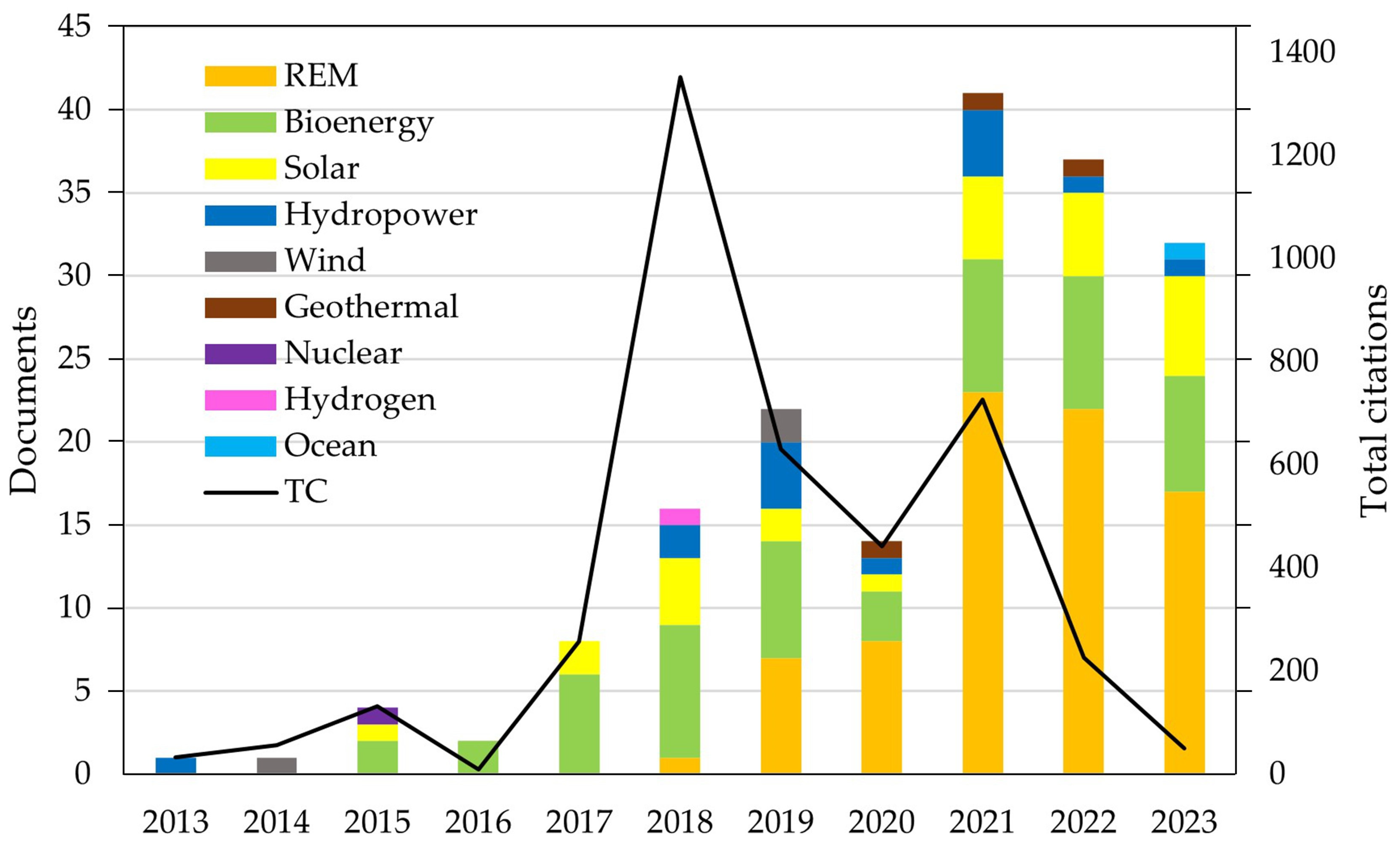
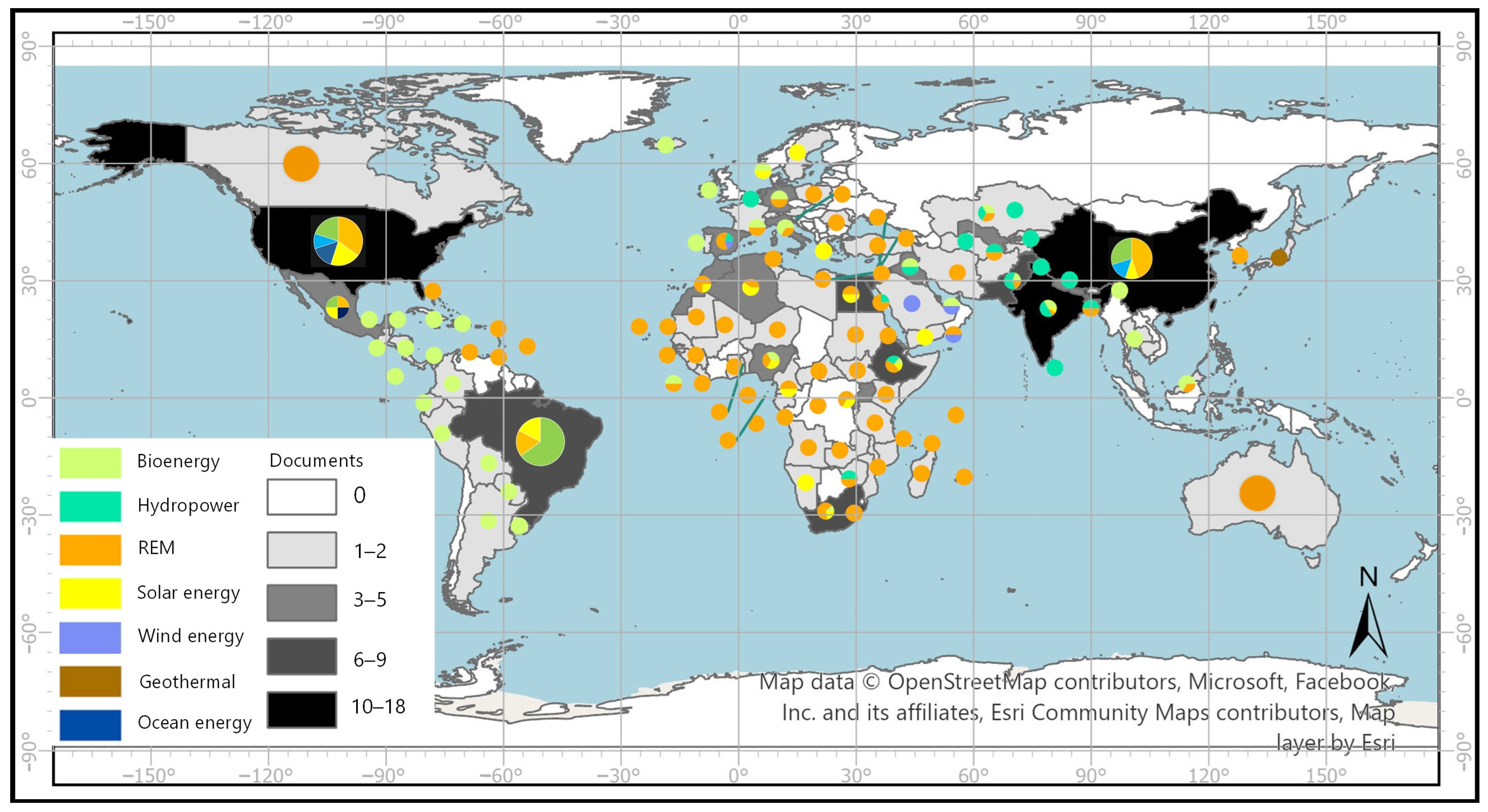
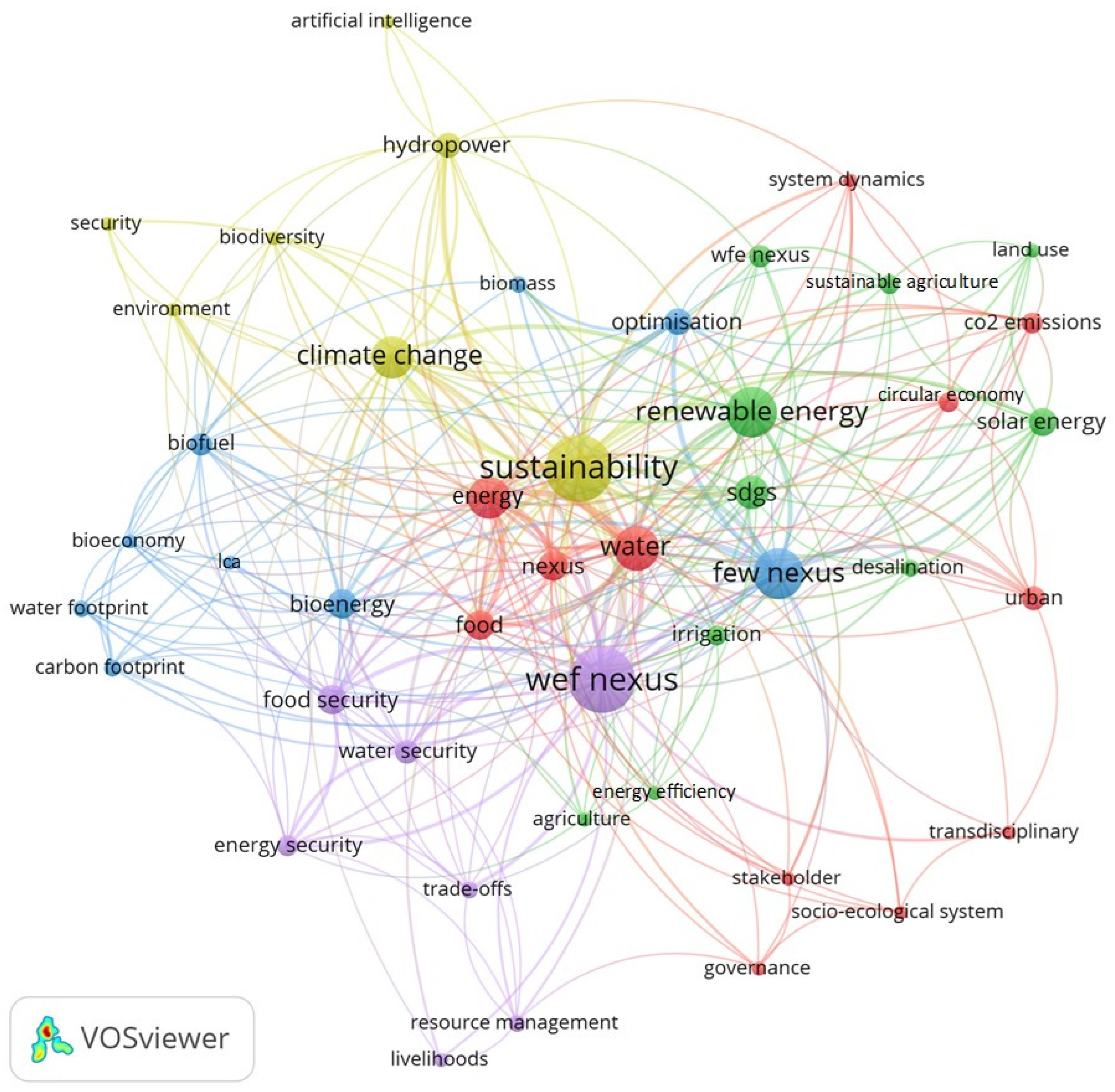
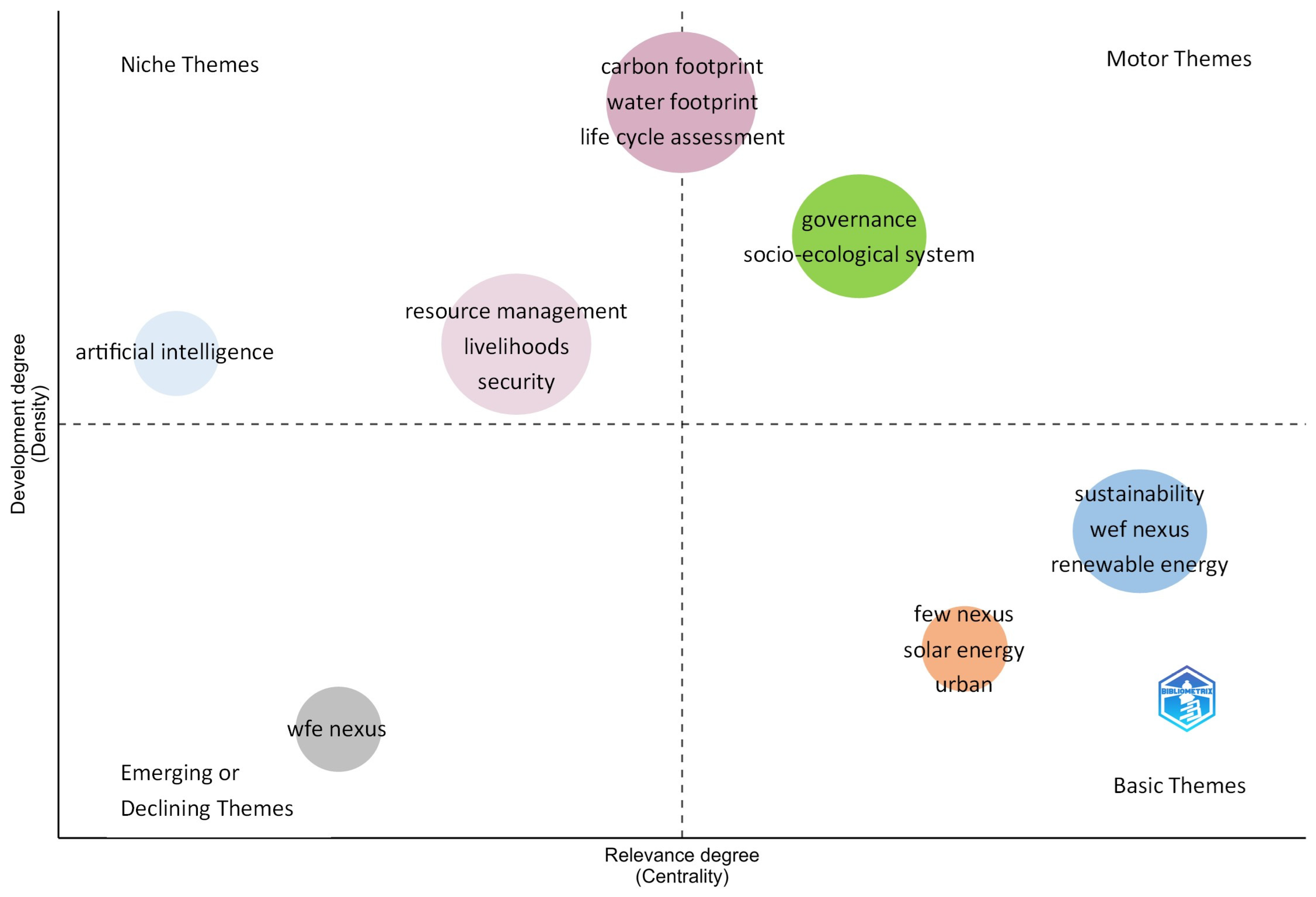
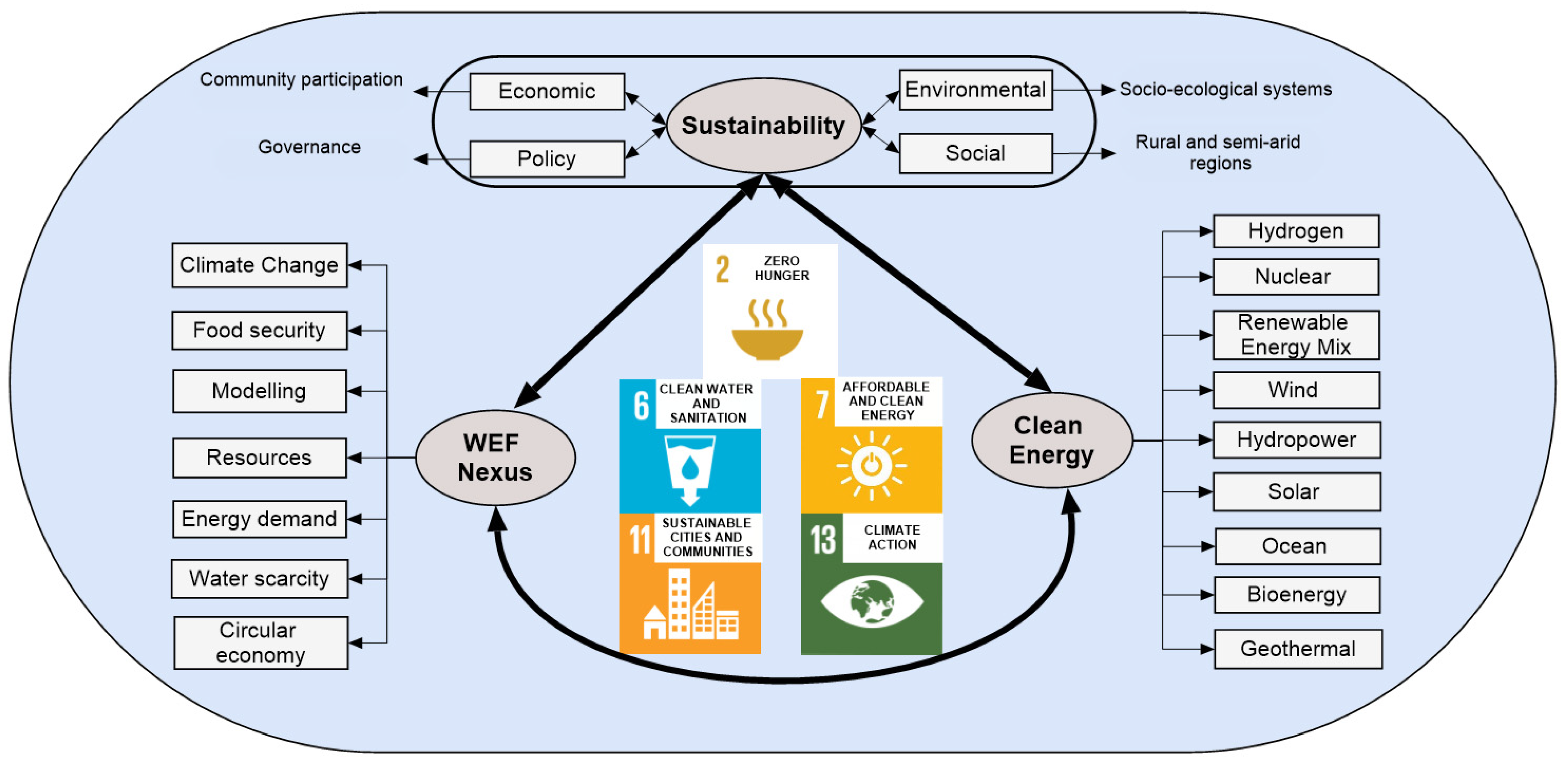
| Clean Energy | Main Contributions | SDGs | References |
|---|---|---|---|
| WEF nexus/renewable energy mix |
| 2; 7; 11; 13 | [34,83,84,85,86,87] |
| WEF nexus/solar energy |
| 7; 2 | [88,89,90] |
| WEF nexus/bioenergy |
| 7; 11 | [91,92,93,94,95] |
| WEF nexus/ hydropower |
| 7; 6; 2 | [59,96,97] |
| WEF nexus/wind energy |
| 7; 6; 2 | [98] |
| WEF nexus/ hydrogen |
| 7; 6 | [99] |
| Income Level | Country | H (%) | B (%) | REM (%) | S (%) | W (%) | T (%) |
|---|---|---|---|---|---|---|---|
| High | China | (✓) (7.67) | (✓) (0.06) | (✓) (1.27) | (✓) (2.51) | (X) (4.49) | 16.00 |
| United States | (✓) (2.53) | (✓) (1.62) | (✓) (0.84) | (✓) (2.01) | (✓) (4.29) | 11.29 | |
| Spain | (✓) (2.97) | (X) (0.97) | (✓) (1.36) | (X) (5.50) | (✓) (10.22) | 21.02 | |
| Upper middle | Brazil | (X) (29.89) | (✓) (6.49) | (✓) (4.52) | (✓) (2.11) | (X) (5.71) | 48.72 |
| South Africa | (X) (0.60) | (✓) (0.07) | (✓) (0.10) | (✓) (1.20) | (X) (1.89) | 3.86 | |
| Ecuador | (X) (29.36) | (✓) (0.08) | (X) (0.56) | (X) (0.04) | (X) (0.07) | 30.11 | |
| Low middle | Egypt | (X) (3.25) | - | (X) (0.00) | (✓) (1.18) | (X) (1.21) | 5.64 |
| Pakistan | (✓) (9.13) | (X) (0.00) | (✓) (0.28) | (X) (0.23) | (X) (1.21) | 10.85 | |
| Algeria | (X) (0.02) | - | (X) | (✓) (0.26) | (X) (0.004) | 0.284 |
Disclaimer/Publisher’s Note: The statements, opinions and data contained in all publications are solely those of the individual author(s) and contributor(s) and not of MDPI and/or the editor(s). MDPI and/or the editor(s) disclaim responsibility for any injury to people or property resulting from any ideas, methods, instructions or products referred to in the content. |
© 2024 by the authors. Licensee MDPI, Basel, Switzerland. This article is an open access article distributed under the terms and conditions of the Creative Commons Attribution (CC BY) license (https://creativecommons.org/licenses/by/4.0/).
Share and Cite
Herrera-Franco, G.; Bravo-Montero, L.; Caicedo-Potosí, J.; Carrión-Mero, P. A Sustainability Approach between the Water–Energy–Food Nexus and Clean Energy. Water 2024, 16, 1017. https://doi.org/10.3390/w16071017
Herrera-Franco G, Bravo-Montero L, Caicedo-Potosí J, Carrión-Mero P. A Sustainability Approach between the Water–Energy–Food Nexus and Clean Energy. Water. 2024; 16(7):1017. https://doi.org/10.3390/w16071017
Chicago/Turabian StyleHerrera-Franco, Gricelda, Lady Bravo-Montero, Jhon Caicedo-Potosí, and Paúl Carrión-Mero. 2024. "A Sustainability Approach between the Water–Energy–Food Nexus and Clean Energy" Water 16, no. 7: 1017. https://doi.org/10.3390/w16071017
APA StyleHerrera-Franco, G., Bravo-Montero, L., Caicedo-Potosí, J., & Carrión-Mero, P. (2024). A Sustainability Approach between the Water–Energy–Food Nexus and Clean Energy. Water, 16(7), 1017. https://doi.org/10.3390/w16071017










